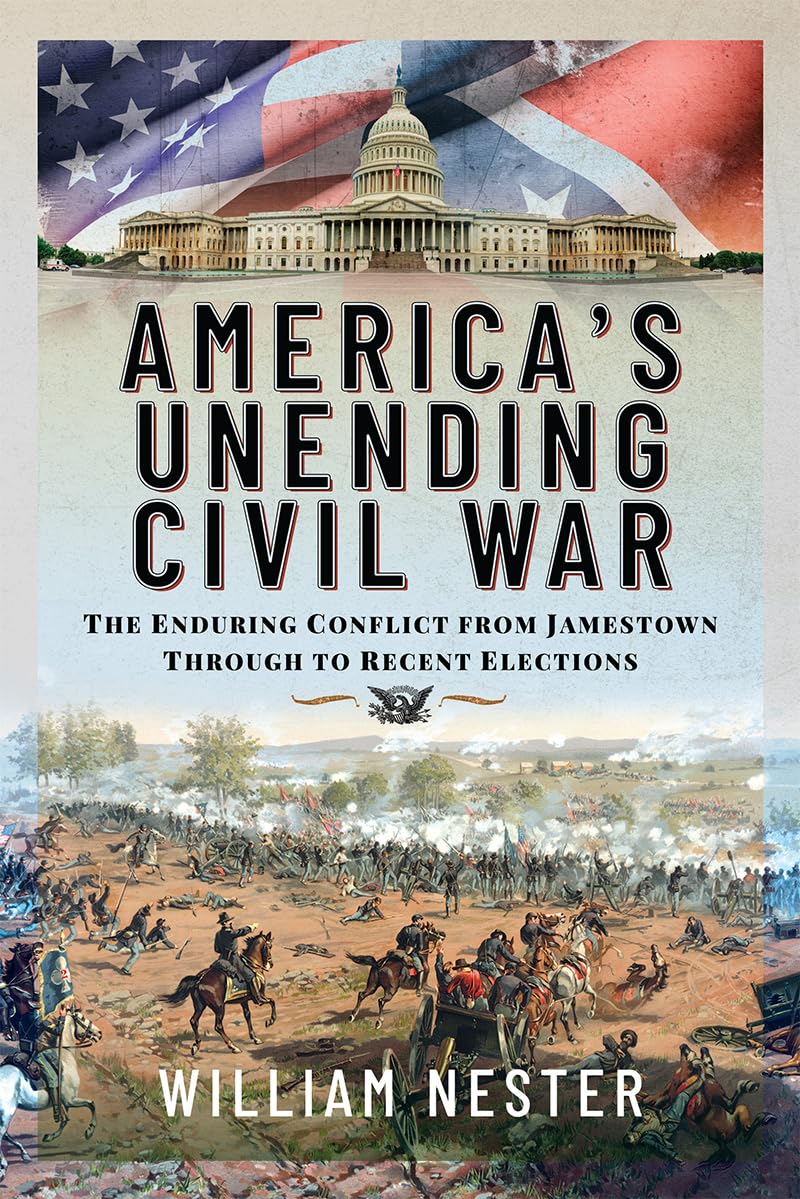Book Review: America’s Unending Civil War: The Enduring Conflict from Jamestown through to Recent Elections

 America’s Unending Civil War: The Enduring Conflict from Jamestown through to Recent Elections. By William R. Nester. Philadelphia: Frontline Books, 2024. Hardcover, 272 pp. $21.63.
America’s Unending Civil War: The Enduring Conflict from Jamestown through to Recent Elections. By William R. Nester. Philadelphia: Frontline Books, 2024. Hardcover, 272 pp. $21.63.
Reviewed by Evan Portman
America is still fighting the Civil War. That is the argument that William R. Nester makes in his recent book America’s Unending Civil War: The Enduring Conflict from Jamestown through to Recent Elections. In just 213 pages, Nester effectively traces controversial social and economic issues from the time of this country’s founding to its present divisiveness.
Beginning in 1607 with the founding of Jamestown, Nester provides a broad overview of American history while also contextualizing the causes and themes of the Civil War. In his introduction, he convincingly places slavery as the war’s “core cause” but also acknowledges that the war culminated in a plethora of other “chronic conflicts over the nature of government, citizenship, liberty, property, voting, equality, wealth, race, identity, crime, justice, power, and history from the nation’s origins” (x). Thus, Nester characterizes the “unending conflict” of the Civil War in a way that succinctly captures the contradictions entwined within our national creed.
A particular attribute of America’s Unending Civil War is Nester’s ability to weave informative statistics into his narrative in an engaging way. He offers numbers and charts that reveal important information about the war and its legacy, including the frequency of desertion, mortality rates, ethnicity, voting data, Southern and Northern demographics, and the financial cost of wars throughout American history. Nester integrates this data in a way that does not detract from his engaging prose but, instead, bolsters his argument and narrative. Through these statistics, he effectively captures the complex socioeconomic differences between North and South in just a few pages.
One flaw in America’s Unending Civil War is Nester’s watering down of the Hamiltonian and Jeffersonian political philosophies. He accurately describes Alexander Hamilton’s desire for the United States to become “an increasingly powerful, diversified, urban, middle-class economy” defended by a “muscular problem-solving national government,” while Thomas Jefferson wanted the country to remain agrarian under a limited national government. However, Nester makes clear his preference for the Hamiltonian vision and characterizes Jeffersonian policies as a hindrance to national progress. While this view holds some merit, it is an oversimplification of the antebellum political climate.
Nester also writes that Hamilton’s Federalist Party transformed into the Whig Party of the 1830s and 1840s, and eventually the Republican Party. On the other hand, Jefferson’s Republican Democrats transformed into the Democratic Party under President Andrew Jackson. These parties, Nester argues, “traded ideological places over the preceding century and a half” following the Civil War (209). The Democratic Party, once conservative, is now liberal, while the Republican Party, once progressive, is now conservative. While this may be true from a certain point of view, Nester’s analysis of America’s political parties is watered down. During the Civil War, the Republican Party fostered both a radical and conservative faction, a fact Nester acknowledges. And not all 19th Century Republicans were socially progressive; the party harbored a contingent of nativists left over from the Know Nothing Party. Indeed, the transformation of America’s political parties into what they are today did not occur as simply as Nester suggests.
Nester devotes much of his work to the war itself and its lead up. He therefore only leaves about two chapters for a discussion of the war’s legacy and how it transcends the 1860s. This is both a strength and a weakness, as it allows for a rich analysis of the war’s battles and causes but reduces its complex aftermath, impact, and repercussions to a mere epilogue. In his final chapter, Nester calls the reader’s attention to two contemporary forces that he holds accountable for obstruction of racial, social, and economic progress in the present day: the Black Lives Matter Movement and President Donald Trump. This analysis will likely incense members of both political parties, but Nester backs his argument up with persuasive statistics regarding the relatively low number of black suspects killed by police as well as Trump’s civil and criminal charges. He also argues that the murder of criminal suspect George Floyd by Officer Derek Chauvin (who Nester misidentifies as “Derek Owen”) inspired a national reckoning that can be traced to the same issues of America’s “unending conflict”. This reckoning, Nester posits, was exacerbated by some violent BLM protests, destruction of Confederate monuments, and Trump’s inflammatory rhetoric.
Despite several flaws in content and focus, Nester’s America’s Unending Civil War provides a solid, comprehensive overview of the Civil War and contextualizes it within the ongoing struggle for freedom and liberty. While the book does not provide intricate details of battles and campaigns that knowledgeable readers may be looking for, it appeals to a novice audience seeking answers from the past to inform events in the present.